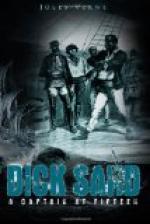At last, on that day, at ten o’clock in the morning, the “Pilgrim” was sailing under her foresail, her top-sail, and her jib.
Dick Sand had not judged it prudent to set more sail. The canvas which he carried ought to assure him, as long as the wind did not moderate, a speed of at least two hundred miles in twenty-four hours, and he did not need any greater to reach the American coast before ten days.
The novice was indeed satisfied when, returning to the wheel, he again took his post, after thanking Master Jack, assistant helmsman of the “Pilgrim.” He was no longer at the mercy of the waves. He was making headway. His joy will be understood by all those who are somewhat familiar with the things of the sea.
The next day the clouds still ran with the same velocity, but they left large openings between them, through which the rays of the sun made their way to the surface of the waters. The “Pilgrim” was at times overspread with them. A good thing is that vivifying light! Sometimes it was extinguished behind a large mass of vapors which came up in the east, then it reappeared, to disappear again, but the weather was becoming fine again.
The scuttles had been opened to ventilate the interior of the ship. A salubrious air penetrated the hold, the rear hatchway, the crew’s quarters. They put the wet sails to dry, stretching them out in the sun. The deck was also cleaned. Dick Sand did not wish his ship to arrive in port without having made a bit of toilet. Without overworking the crew, a few hours spent each day at that work would bring it to a good end.
Though the novice could no longer throw the log, he was so accustomed to estimating the headway of a ship that he could take a close account of her speed. He had then no doubt of reaching land before seven days, and he gave that opinion to Mrs. Weldon, after showing her, on the chart, the probable position of the ship.
“Well, at what point of the coast shall we arrive, my dear Dick?” she asked him.
“Here, Mrs. Weldon,” replied the novice, indicating that long coast line which extends from Peru to Chili. “I do not know how to be more exact. Here is the Isle of Paques, that we have left behind in the west, and, by the direction of the wind, which has been constant, I conclude that we shall reach land in the east. Ports are quite numerous on that coast, but to name the one we shall have in view when we make the land is impossible at this moment.”
“Well, Dick, whichever it may be, that port will be welcome.”
“Yes, Mrs. Weldon, and you will certainly find there the means to return promptly to San Francisco. The Pacific Navigation Company has a very well organized service on this coast. Its steamers touch at the principal points of the coast; nothing will be easier than to take passage for California.”
“Then you do not count on bringing the ‘Pilgrim’ to San Francisco?” asked Mrs. Weldon.




